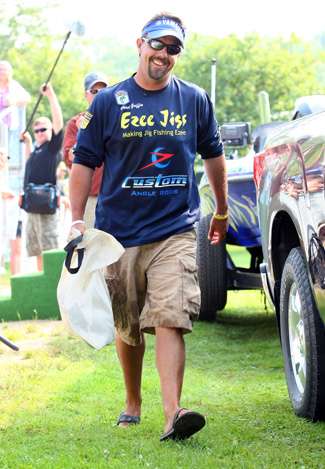
SYRACUSE, N.Y. — Up until now, Elite Series trips to Oneida Lake have meant anticipation of fabulous smallmouth fishing followed by winning creels that consisted entirely of largemouths. This week, rookie Chad Griffin's victory at the Ramada Champion's Choice marked a movement back toward expectations, though, as his winning catch consisted of both species.
Granted, we still haven't seen an all-bronzeback winner at Oneida in Elite Series competition — and since the tour won't return here next year we won't in the foreseeable future — but at least the possibility can now be broached.
Fifth-place finisher Jason Quinn said he believes even the locals would be surprised by the size of the smallmouths that live in this lake.
I thought 15 to 18 pounds a day of them was possible," he said. "They're here. By God, they're here, but the people up here don't know how to fish for them."
Given that knowledge, if he had another shot here Quinn would stick with his all-brown plan again.
"I don't even fish for (largemouths)," he said. "They get hammered in practice and they get hammered in the tournament."
The Oneida largemouth bite became a full-fledged phenomenon after Tommy Biffle won here in 2006, but even he believes that it would take a perfect storm of conditions to be able to win again entirely with green fish.
"When we first came here nobody knew that they lived that shallow," he said of fish that are still reportedly caught in as little as six to eight inches of water."
But via the internet and television, and good old word of mouth, the word got out. Nothing stays a secret very long with this group. As a result, 98 anglers had to at least consider the largemouth bite, and the resulting focus took its toll.
"It's just the nature of the pressure," Biffle said. "I said before we ever got here that when you get 50 or 60 guys looking for them for all of practice, then during the first two days of the tournament, and whatever makes the cut, there's just not enough to go around, and you know they're all going to be swinging for them."
But pre-tournament prognostications like Biffle's have to be taken with a grain of salt. When anglers make those pronouncements, are they just seeking to throw their competition off the scent of a winning pattern?
In this case, Biffle was true to his word.
"After practice, I knew that there were not many good ones up there," he said. "You can flip for a long time and not get a bite."
Accordingly, he tried to catch 13 to 15 pounds of smallmouth each day and would spend the rest of the day flipping for shallow largemouths with a variety of creature baits. That strategy enabled him to slide into the two-event postseason.
Another angler who stayed true to his pre-tournament promises was Dean Rojas, who won here last year and was leading the 2007 Major here when the field left Oneida for the hole course on nearby Onondaga.
Rojas vowed before this year's tournament started that he'd put on his blinders and set a laser focus on shallow water largemouths, and he lived up to that promise.
Rojas did inadvertently land an apparently confused smallmouth during practice, but his four tournament limits were composed entirely of largemouths, and they led him to a third-place result. That finish was more than enough to boost him from outside of the Classic cut into February's tournament.
"Smallmouth are becoming more of a factor, but I'm sticking to my guns," he said. "It's a lot easier way of fishing, instead of going out deep and trying to find sweet spots." He reported that he caught 80 percent of his fish on his signature Bronzeye Frog (Midnight Walker) and flipped up the rest.
"I wouldn't change a thing," Rojas said. "A lot of it is timing and knowing the areas. It's a fun way to fish and it's what I enjoy doing."

